
Idanha is a city on the Marion County/Linn County line in Oregon, United States, on Oregon Route 22 and the Santiam River. The population was 156 at the 2020 census.

Detroit Lake is a reservoir impounded by the Detroit Dam on the North Santiam River 46 miles (74 km) southeast of Salem, Oregon, United States. The lake is adjacent to Oregon Route 22 near the city of Detroit. This mesotrophic lake stores water for use by the city of Salem and other nearby communities.

The Yaquina River is a stream, 59 miles (95 km) long, on the Pacific coast of the U.S. state of Oregon. It drains an area of the Central Oregon Coast Range west of the Willamette Valley near Newport.
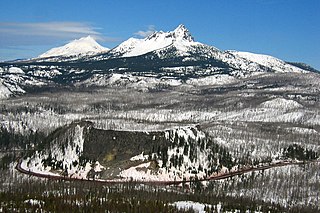
Santiam Pass is a 4,817-foot (1,468 m) mountain pass in the Cascade Range in central Oregon in the United States. It is located on the border between Linn and Jefferson counties, about 18 mi (29 km) northwest of Sisters, between the prominent volcanic horns of Three Fingered Jack to the north and Mount Washington to the south. Several other smaller volcanoes, including cinder cones and tuyas, are found near the summit of the pass. U.S. Route 20 connects eastern Oregon with the valley of the Santiam River on the west via Santiam Pass. One of the 19 or 20 lakes by the name of Lost Lake is located beside the highway just west of Santiam Pass. The pass may be approached from the west by three distinct routes:

SS Valencia was an iron-hulled passenger steamer built for the Red D Line for service between Venezuela and New York City. She was built in 1882 by William Cramp and Sons, one year after the construction of her sister ship Caracas. She was a 1,598-ton vessel, 252 feet (77 m) in length. In 1897, Valencia was deliberately attacked by the Spanish cruiser Reina Mercedes off Guantanamo Bay, Cuba. The next year, she became a coastal passenger liner on the U.S. West Coast and served periodically in the Spanish–American War as a troopship to the Philippines. Valencia was wrecked off Cape Beale, which is near Clo-oose, on the west coast of Vancouver Island, British Columbia, on 22 January 1906. As her sinking killed 100 people, some classify the wreck of Valencia as the worst maritime disaster in the "Graveyard of the Pacific", a famously treacherous area off the southwest coast of Vancouver Island.

The Oregon Railroad and Navigation Company (OR&N) was a rail and steamboat transport company that operated a rail network of 1,143 miles (1,839 km) running east from Portland, Oregon, United States, to northeastern Oregon, northeastern Washington, and northern Idaho. It operated from 1896 as a consolidation of several smaller railroads.
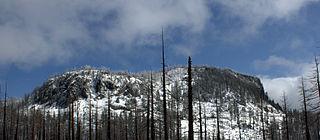
Hogg Rock is a tuya volcano and lava dome in the Cascade Range of northern Oregon, United States, located close to Santiam Pass. Produced by magma with an intermediate andesite composition, it has steep slopes and thick glassy margins. Hogg Rock exhibits normal magnetic polarity and is probably about 80,000 years old.

Seal Rock is an unincorporated coastal community in Lincoln County, Oregon, United States, between Newport and Waldport on U.S. Route 101.

The history of steamboats on the Oregon Coast begins in the late 19th century. Before the development of modern road and rail networks, transportation on the coast of Oregon was largely water-borne. This article focuses on inland steamboats and similar craft operating in, from south to north on the coast: Rogue River, Coquille River, Coos Bay, Umpqua River, Siuslaw Bay, Yaquina Bay, Siletz River, and Tillamook Bay. The boats were all very small, nothing like the big sternwheelers and propeller boats that ran on the Columbia River or Puget Sound. There were many of them, however, and they came to be known as the "mosquito fleet."

Yaquina Bay, like Coos Bay, is a shallow coastal bay on the Oregon Coast in the Pacific Northwest of North America. The principal town on Yaquina Bay is Newport, Oregon. The Yaquina River flows into the bay. Until modern roads reached Newport in the late 1920s, the principal transportation method to and from Newport was by ship or boat.

Santiam Junction is a highway junction and unincorporated community in Linn County, Oregon, United States, at the intersection of U.S. Route 20/Oregon Route 126 and Oregon Route 22.
Thomas Egenton Hogg (1828–1898) was a master in the Confederate States Navy who participated in raids on Union ships during the American Civil War. He was captured and sentenced to death, but was eventually released from prison, after which he became a businessman and railroad promoter in the U.S. state of Oregon. He worked to build the Oregon Pacific Railroad, though his dream to create a transcontinental railroad with its western terminus on the Oregon Coast was never realized.
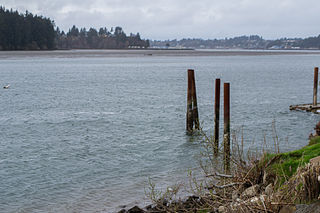
Yaquina, at one time a thriving port called Yaquina City, is an unincorporated community in Lincoln County, in the U.S. state of Oregon. It is near the mouth of the Yaquina River, on the east side of Yaquina Bay, and is a 3-to-4-mile drive from Newport. The Oregon Press Association, which became the Oregon Newspaper Publishers Association, was founded in Yaquina City in 1887.
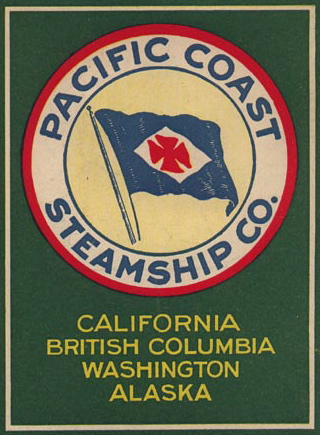
The Pacific Coast Steamship Company was an important early shipping company that operated steamships on the west coast of North America. It was first organized in 1867 under the name Goodall, Nelson and Perkins. The Goodall, Nelson & Perkins Steamship Company was formed in 1875, but a year later was reorganized as the Pacific Coast Steamship Company. In 1916 the Admiral Line bought the shipping interests of the company.

T.M. Richardson was a steamboat built in 1888 at Oneatta, Oregon, which served on Yaquina Bay and on the Yaquina River from 1888 to 1908. This vessel was commonly known as the Richardson or the T.M.

The SS Caracas (1881–1889) was a coastal passenger steamship built by William Cramp & Sons in Philadelphia. She was the older sister ship to the Valencia. Both Caracas and Valencia served from New York City to Venezuela. The short life of Caracas ended in 1889, when she ran aground in Yaquina Bay under the name Yaquina Bay.
The Willamette Valley & Coast Railroad (WV&C) was a small 19th-century railway line in the American state of Oregon which sought to cross the Coast Mountain Range to connect the agriculturally oriented Willamette Valley with international shipping at Yaquina Bay. Following three false starts during the ten years after the American Civil War, the railway was launched in July 1874. Work was completed on the valley-to-coast road in 1884. The line is today operated by Portland and Western Railroad.

Newport was an American steamboat built in 1908 at Yaquina City, Oregon. Now a ghost town, Yaquina City was then the terminus of the Corvallis & Eastern Railroad. For many years Newport transported excursionists in the summer months across a short water route between Yaquina City and the town of Newport, Oregon.
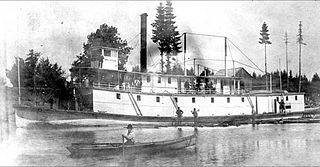
Three Sisters was a sternwheel-driven steamboat that operated on the Willamette River from 1886 to 1896. The steamer was built as an extreme shallow-draft vessel, to permit it to reach points on the upper Willamette river such as Corvallis, Harrisburg and Eugene, Oregon during summer months when water levels in the river were generally low. The vessel was also known for having been washed up on a county road in Oregon during a flood in 1890.
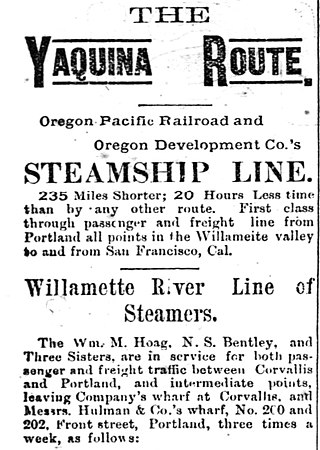
N.S. Bentley, commonly referred to as simply Bentley, was a stern-wheel driven steamboat that operated on the Willamette rivers. Launched in East Portland in December 1886, Bentley ran until 1896, when it was rebuilt and renamed Albany. Bentley was owned by the Oregon Pacific Railway, and was used as part of a rail and marine link from Portland to San Francisco, running down the Willamette, then to Yaquina Bay, and then by ocean steamer south to California. In 1896, Bentley was rebuilt and renamed Albany.





















